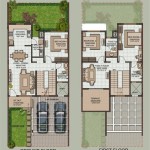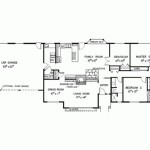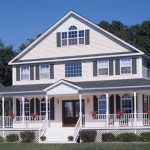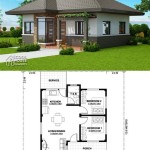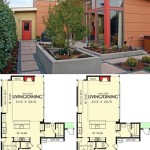Gothic Revival Home Plans: A Deep Dive into Architectural History and Modern Design
Gothic Revival architecture, a movement that gained prominence in the mid-19th century, represents a romantic and picturesque alternative to the classical styles that preceded it. Rooted in a deep appreciation for the medieval Gothic architecture of Europe, particularly cathedrals and castles, the style translates these historical elements into residential dwellings. This article will explore the key characteristics of Gothic Revival home plans, analyze the historical context that informed its development, and discuss how these plans are adapted and interpreted in contemporary architectural design.
The Gothic Revival style, sometimes referred to as Victorian Gothic or Neo-Gothic, is characterized by pointed arches, steeply pitched roofs, gabled dormers, and elaborate ornamentation. Unlike the symmetrical and balanced designs of Georgian or Greek Revival architecture, Gothic Revival embraces asymmetry and verticality, creating a visually dynamic and visually imposing presence. These homes often feature details such as quatrefoil windows, tracery, finials, and battlements, all borrowed from medieval buildings. The use of materials like stone, brick, and dark wood further reinforces the historical aesthetic.
The movement arose as a reaction against the perceived coldness and impersonality of Classical architecture, and was driven by a desire to recapture the perceived spirituality and craftsmanship of the Middle Ages. Architects sought to imbue buildings with a sense of history, tradition, and moral purpose, reflecting a broader cultural interest in the past and a rejection of industrialization. This enthusiasm manifested not only in grand cathedrals and public buildings but also in private residences, allowing homeowners to express their appreciation for history and artistic values.
Key Characteristics of Gothic Revival Home Plans
Gothic Revival home plans share several distinctive features that distinguish them from other architectural styles. These characteristics are not merely decorative; they are integral to the structure and the overall aesthetic of the building.
Firstly, the pointed arch is arguably the most recognizable element. Used extensively in windows, doorways, and decorative elements, the pointed arch creates a sense of height and visual interest. This arch form is not only aesthetically pleasing but also structurally efficient, allowing for larger openings and greater distribution of weight. The pointed arch is more than just a shape; it is a symbol of Gothic architecture itself. In modern adaptations, architects may incorporate the pointed arch in subtle ways, such as in window headers or interior arches, to evoke the Gothic aesthetic without overwhelming the design.
Secondly, steeply pitched roofs and gables are essential features. High-pitched roofs, often accentuated with dormers, create a dramatic silhouette and contribute to the verticality of the structure. Gables, the triangular portions of the wall between the sloping edges of intersecting roof pitches, are frequently adorned with bargeboards, which are decorative trim pieces along the gable verge. Bargeboards can be intricately carved or pierced with designs such as trefoils or quatrefoils, adding to the ornamentation of the roofline. The combination of steep roof pitches and embellished gables creates a strong visual impact, drawing the eye upward and emphasizing the height of the building.
Thirdly, asymmetrical layouts and intricate ornamentation are vital. Unlike the symmetrical designs of classical styles, Gothic Revival homes often feature asymmetrical floor plans, with wings, towers, and projecting bays creating a varied and picturesque facade. This asymmetry extends to the interior, with rooms arranged in a non-uniform manner. Ornamentation is equally important, with details such as tracery (decorative stone or wood patterns in windows or panels), finials (ornamental features at the apex of a gable or pinnacle), and crenellations (battlements along the roofline) adding to the visual richness. The ornamentation may be found throughout the building, both inside and out, reflecting the dedication to craftsmanship and historical detail.
Historical Context: The Roots of the Gothic Revival
Understanding the historical origins of the Gothic Revival is essential for appreciating its significance and design principles. The movement did not emerge in a vacuum; it was the product of specific social, political, and intellectual trends.
The initial stirrings of the Gothic Revival can be traced back to the late 18th century in England, spurred by intellectual and artistic currents embracing Romanticism. The Romantic movement emphasized emotion, imagination, and a reverence for the past, particularly the Middle Ages. Figures like Horace Walpole, who constructed Strawberry Hill House in Twickenham, England, experimented with Gothic elements, demonstrating an early fascination with the style. However, these early efforts were often playful and whimsical, lacking the intellectual rigor and historical accuracy that would characterize later Gothic Revival designs.
The formalization and widespread adoption of the Gothic Revival occurred in the mid-19th century, largely due to the influence of architectural theorists like Augustus Pugin. Pugin, a devout Catholic, believed that Gothic architecture was not merely a style but an expression of moral and religious values. He argued that the simple, functional designs of medieval buildings reflected a more virtuous and spiritual society, contrasting with the perceived materialism and decadence of the modern age. Pugin advocated for a return to authentic Gothic principles, emphasizing honesty in construction, the use of traditional materials, and the integration of architecture with the decorative arts. His writings, particularly "Contrasts" (1836), had a profound impact on the development of the Gothic Revival, shaping the architectural thinking of his contemporaries and inspiring generations of architects to come.
The Gothic Revival also received a boost from the rise of the Oxford Movement within the Church of England, which sought to restore Catholic traditions and practices. This movement fueled the construction of numerous Gothic Revival churches, solidifying the style's association with religious institutions and moral rectitude. Architects like Sir George Gilbert Scott, a leading figure in the Victorian Gothic, designed numerous churches and cathedrals, further establishing the Gothic Revival as the dominant architectural style for religious buildings. The influence of the Gothic Revival extended beyond religious architecture, however, influencing the design of schools, government buildings, and private residences.
Modern Interpretations of Gothic Revival Home Plans
While adherence to historical accuracy was initially a defining aspect of the Gothic Revival, modern interpretations of the style often incorporate contemporary design principles and materials. Contemporary architects seek to capture the essence of the Gothic Revival while creating homes that meet the needs and preferences of modern homeowners. This balance requires a nuanced understanding of both the historical style and the demands of contemporary living.
One key aspect of modern adaptations is the integration of modern building technologies and materials. While historical Gothic Revival homes were typically constructed using traditional materials like stone, brick, and wood, contemporary builders may incorporate steel, concrete, and engineered wood products to enhance structural integrity, energy efficiency, and longevity. The use of modern insulation, windows, and HVAC systems can significantly improve the comfort and sustainability of a Gothic Revival-inspired home. These enhancements are often seamlessly integrated into the design, maintaining the aesthetic integrity of the style while providing the benefits of modern technology.
Another trend in modern Gothic Revival home plans is the simplification of ornamentation. While historical examples often featured elaborate and intricate detailing, contemporary designs may opt for a more restrained approach, focusing on key Gothic elements rather than replicating every aspect of the original style. This simplification can make the design more affordable and easier to maintain while still capturing the essence of the Gothic Revival. Architects may choose to focus on specific details, such as pointed arches, steeply pitched roofs, and decorative bargeboards, while omitting less essential embellishments. This selective approach allows for a modern interpretation that is both aesthetically pleasing and practically feasible.
Furthermore, modern Gothic Revival home plans often prioritize functionality and livability. Historical Gothic Revival homes were not always designed with modern conveniences in mind, and their layouts could be somewhat impractical for contemporary lifestyles. Modern architects address this by creating open and flexible floor plans that accommodate the needs of modern families. They may incorporate features such as spacious kitchens, luxurious bathrooms, and integrated home technology, while still maintaining the Gothic aesthetic. This balance between historical style and modern functionality is essential for creating Gothic Revival-inspired homes that are both beautiful and livable. The integration of large windows to allow for ample natural light, a feature often lacking in traditional Gothic structures, is also a common adaptation to enhance the indoor environment.
In conclusion, Gothic Revival home plans represent a fascinating blend of historical inspiration and modern design. By understanding the key characteristics of the style, its historical context, and the ways in which it is being adapted for contemporary living, it is possible to appreciate the enduring appeal of this unique architectural movement. As long as homeowners continue to be drawn to its romantic and picturesque qualities, the Gothic Revival will persist as a distinctive and influential style in residential architecture.

Gothic Revival House Plans Google Search Victorian Vintage Floor

Gothic Revival Style Christine Huckins Franck Architect Llc House Vintage Plans Architecture

Charming Gothic Revival Cottage 1204 Sq Ft Architectural Designs 43002pf House Plans

Gothic Revival An Alternative Trend For Victorian Americans House Plans Historic Preservation Architecture

Charming Gothic Revival Farmhouse 43071pf Architectural Designs House Plans

Archi Maps Gothic House Victorian Plans Architecture

Gothic Revival Style House Plans Floor

Gothic Revival Splendor 12206jl Architectural Designs House Plans

58 Best Gothic Floor Plans Ideas Vintage House

Gothic Revival House Plans Floor For Builders
Related Posts

